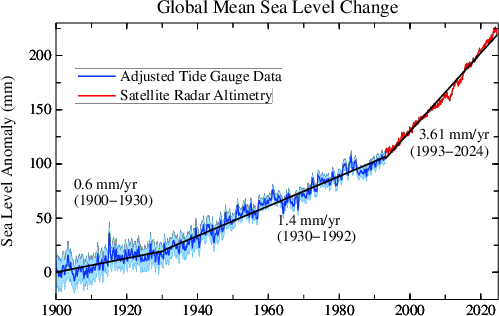Have you ever gazed at the horizon, the line where ocean meets sky, and pondered the age-old question: Are our seas on an uphill trajectory? It’s a thought-provoking query that merits examination, and the historical data offers a resounding confirmation—the oceans have indeed been rising. An exploration into the depths of this phenomenon not only uncovers the factual evidence but also propels us toward a contemplative discussion about its implications.
To navigate this vast body of understanding, let’s journey through the historical milestones of sea-level data, examine the causative factors, and reflect on what these changes portend for humanity and our environment.
The Historical Narrative of Sea-Level Change
Delving into the annals of our earth’s climate history reveals an intricate tapestry of sea-level fluctuations. Prior to the 20th century, evidence indicates that sea levels were relatively stable, barring the natural variances intrinsic to glacial and interglacial periods. Typically measured using tide gauges, early record-keeping presents a somewhat fragmented but coherent picture. From the late 1800s through the early 1900s, tide gauges in coastal cities such as New York and Tokyo documented a gradual increase in sea level, often attributed to thermal expansion of water and glacial melting.
Fast-forward to the latter half of the 20th century, and the narrative becomes decidedly more alarming. Data compiled from satellite altimetry since the 1990s has unveiled a more comprehensive and precise understanding of ocean-level changes. This technology advocates for the observation of global sea-level trends, revealing that sea levels have risen approximately 3.3 millimeters per year on average from 1993 to 2020. This acceleration in rise has been linked to the twin phenomena of anthropogenic climate change contributing to heightened glacial melt and the thermal expansion of seawater as it warms.
The Role of Human Activity: A Catalyst for Rising Tides
One cannot explore sea-level rise without confronting the stark reality of human-induced climate change. The burning of fossil fuels has contributed significantly to the atmospheric greenhouse gas concentrations, which in turn has led to a warming planet. This warming facilitates the melting of polar ice sheets and glaciers, particularly in Greenland and Antarctica, releasing immense volumes of freshwater into our oceans.
Moreover, the thermal expansion of seawater cannot be overstated. As the atmosphere heats up, so too do the oceans—data indicating that the top layers of the sea are warming at an alarming pace. This thermal expansion means that as water heats, it occupies more space, thereby contributing to rising sea levels.
Additionally, land subsidence in many coastal areas—often a result of urban development and water extraction—exacerbates the issue. When the land sinks, it adds to the relative sea-level rise, leading to an impending sense of urgency and concern for at-risk coastal communities.
Implications of Rising Sea Levels: What Lies Ahead?
With a clearer understanding of the data now laid out, what does the future hold? The implications of rising sea levels are manifold and complex, casting a long shadow over coastal ecosystems and human societies. Scientists project that, under various scenarios of continued greenhouse gas emissions, sea levels could rise by anywhere between 1 to 2 meters by the year 2100. Such a staggering prospect poses existential threats to millions living in low-lying areas, particularly in regions like Southeast Asia and the American coastline.
As coastal cities grapple with the reality of encroaching waters, the challenge transforms into an adaptive paradigm. Cities globally are initiating plans to bolster their resilience against flooding and erosion through infrastructure improvements. Innovative solutions, including tidal barriers and nature-based interventions like restoring mangroves and wetlands, offer promising avenues for mitigating the detrimental effects of rising seas.
Furthermore, the socio-economic ramifications cannot be ignored. The displacement of populations, known as climate refugees, could ignite tensions over resources, land ownership, and national sovereignty. The cornerstone of our collective future hinges on how we address and adapt to these realities.
Inquiries into our collective future are met with insightful solutions and actions that can support a sustainable trajectory. Reinvigorating commitment to global emissions reductions, prioritizing green infrastructure, and revitalizing coastal ecosystems are essential steps toward fostering resilience against the forecasts of ocean-level rise.
Conclusion: A Call to Awareness and Action
In the grand tapestry of our planet’s climatic evolution, rising sea levels serve as both a challenge and an opportunity for renewal. As history recounts the evidence of systemic change, it compels us to engage actively with the implications of these shifts in our environmental purview. While the facts show a concerning rise in sea levels, they also invite sprightly calls to action—our collective endeavor to protect our coasts and communities now rests in our hands. Generating awareness, bolstering our defenses and altering our trajectories may empower us to not simply face rising tides, but to mold our responses actively as stewards of our planet.








